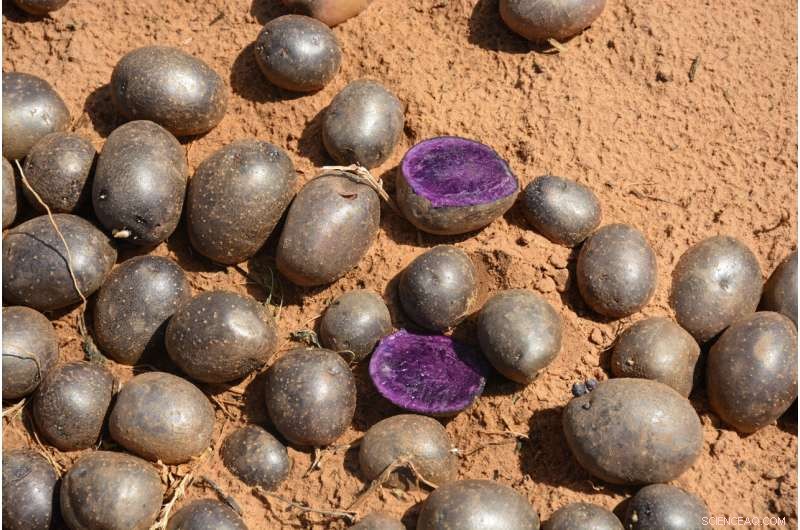
Wetenschap
Het aardappelveredelingsprogramma richt zich op frites, chippen, versmarkten

Een paarsvlezige aardappel is een van de unieke klonen die het Texas A&M AgriLife aardappelveredelingsprogramma teelt in veldproeven bij Springlake. Credit:Texas A&M AgriLife-foto door Kay Ledbetter
Nieuwe aardappelrassen die door het Texas A&M Potato Breeding Program worden veredeld, kunnen binnenkort de markt voor frites betreden, zegt Isabel Vales, Ph.D., Texas A&M AgriLife-aardappelveredelaar in het Department of Horticultural Sciences van het Texas A&M College of Agriculture and Life Sciences .
Op een recente velddag in de zuidelijke High Plains bij Springlake, besprak Vales de nieuwste aardappelklonen die het veredelingsprogramma in de pijplijn zit.
"We zijn behoorlijk enthousiast over een lichtroodbruine experimentele aardappelkloon die een heel speciaal kenmerk heeft:een hoog percentage zetmeel en een hoge zwaartekracht, zelfs onder de zeer stressvolle omstandigheden met hoge temperaturen in Texas," zei Vales. "Ik denk dat de markt voor de verwerking van frites, waarvoor Texas geen verwerkingsroodbruin heeft uitgebracht, een mogelijkheid is."
De experimentele identificatie van de aardappel is COTX08063-2Ru. De eerste kruising is gemaakt in Colorado en de selectie is gemaakt in Texas.
Historisch gezien is Texas geen speler op die markt voor frites, zei Vales, voornamelijk vanwege de zware concurrentie uit het noordwesten, die erg sterk is in die markt.
"Maar ook in Texas kunnen we niet de hoge vaste stoffen krijgen die nodig zijn voor de verwerkingsmarkten. Van alle variëteiten en experimentele klonen die we in de loop van de tijd hebben geëvalueerd, had geen van hen een hoge zwaartekracht," zei Vales. "De experimentele kloon COTX08063-2Ru heeft een hoog soortelijk gewicht, zelfs onder hoge hittestress in Texas, en maakt zeer goede frietjes. Dit is het tweede jaar dat deze kloon deelneemt aan de National French Fry Potato Trials."
Ze zei dat de hoeveelheid zetmeel in aardappelknollen de belangrijkste factor is die het gebruik van een aardappel bepaalt. Hoge vaste stoffen of zwaartekracht betekent dat de aardappelen stevig en compact zijn. De aardappelopbrengst is hoog, evenals het zetmeelgehalte. Aardappelen met een hoog zetmeelgehalte worden vaak gebruikt om bewerkte voedingsmiddelen te maken, zoals friet, frites en gedroogde aardappelen. Aardappelen met een laag tot gemiddeld zetmeelgehalte worden vaak gebruikt voor de verse- of tafelaandelenmarkt.
Collaborating across state lines to reach numerous markets
Vales said the Texas A&M Potato Breeding Program is part of the Southwestern Regional Potato Cultivar Development Project, a multi-state project funded by the U.S. Department of Agriculture National Institute of Food and Agriculture.
"The Southwestern program was established in 1997, and we are celebrating 25 years of successful collaborative work," she said.
In the U.S., Vales explained, there are four regional potato variety development groups involving 12 breeding programs in public land-grant universities and others within the USDA Agricultural Research Service. The regions are Northwestern—Washington, Oregon and Idaho; North Central—North Dakota, Wisconsin, Minnesota and Michigan; Northeastern—North Carolina, New York, Maine and Florida; and Southwestern—Texas, Colorado and California.
"In the southwestern region, we don't have a USDA-ARS contribution like the others do," she said.
Texas A&M University, Colorado State University and the University of California at Davis initiated the Southwestern Regional Potato Cultivar Development Project to meet the unique needs of the region's potato industry, Vales said.
Crosses and original selections are made in Colorado and Texas, followed by regional evaluation trials in all three states and additional states in the western region—Oregon, Idaho and Washington. Some french fry and chipping clones enter national trials every year.
"In the U.S., most potato breeding programs are public," Vales said. "The level of cooperation in potato breeding is unparalleled; potatoes developed by the Southwestern program are planted all over the U.S. and Canada. In the Southwestern region, we also evaluate potatoes developed by other regional programs."
She added that while federal funding is the program's main source for public breeding, other funds come from state departments of agriculture, national commodity groups like Potatoes U.S., foundations and in-kind support from growers. Additional funding comes from royalties derived from varieties released under plant variety protection, PVP, by the Texas A&M program.
"To obtain PVP, we have to declare that the potato varieties are unique, distinct and stable," Vales said. "Seed growers planting PVP varieties must pay royalties. Texas A&M has been very successful in that regard. The amount we received this past year is more than $900,000, and part of that is reinvested in the program."
Field day events introduce Texas A&M varieties, open market outlets
Vales said the trials in various locations across the state and field days are the best way to let growers and the industry know about the latest potato clones in the breeding pipeline.
"This year, we had 180 different clones in the field day display, representing fresh and processing market classes," she said. "Within the processing class, we had chippers and french fry types; within the fresh, we had reds, yellows, purples, smalls and fingerlings."
Around 48 people from various U.S. states and Canada attended the Springlake event. The attendees expressed interest in some clones and shared priorities and challenges with the Texas A&M Potato Breeding Team and other participants.
Early and advanced selected clones included in the field day are also evaluated in agronomic trials in Dalhart and the San Luis Valley, Colorado, as well as California around Bakersfield, South Central Valley and Tulelake, near the Oregon border.
Southwest region presents unique growing conditions, challenges for potatoes
She indicated that cooler nights favor higher yields and fewer tuber defects. Thus, in Texas, the yields get higher with elevation and latitude, which means "we typically obtain much higher yields and better tuber quality out of the Dalhart trials located in the Texas Panhandle."
High temperature during the growing season is a major abiotic stress in several of the Southwestern Region production areas, Vales said. Heat stress can trigger physiological defects and negatively affect tuber yield and quality. Sensitivity to internal tuber heat necrosis, growth cracks, reducing sugar build-up, brown center, hollow heart and heat sprouts are assessed from field-harvested tubers.
"The potato varieties we develop come in different tuber sizes, shapes, skin and flesh textures and colors that fit different market needs," Vales said. "For instance, we collaborate with Tasteful Selections, looking for clones with many small tubers. We are also growing fingerlings and bi-color potatoes. Recently, we developed a round russet with pink eyes and yellow flesh that was provided an exclusive release to explore new market opportunities."
The Texas A&M Norkotah Russet strains continue to be the most popular, with 35 licensees in 12 states, she said. These are fresh-market russets. Two other fresh-market russets growing in popularity are the Reveille Russet, which doubled acreage from 2020 to 2021, and Vanguard Russet. The heat tolerance and long dormancy of Reveille Russet and Vanguard Russet are attractive features to growers across the U.S. and Canada.
Expanding potato markets beyond the Southwestern Region
Potato entries are evaluated in each state's trials for numerous traits, including chip and french fry quality, Vales said. Top entries move to Southwestern for two years and Western Regional Trials for up to three years. Superior clones are released as new varieties. Also, Colorado, Texas and California participate in National Chip Processing Trials and the National Fry Processors Trials. Advanced selections are also sent to collaborators all over the U.S. and Canada.
Vales said the Southwestern Region Project shares breeding stocks and advanced selections with a dozen other states. Since the inception of the Southwestern Regional Potato Cultivar Development Project, 66 new cultivars and clonal selections have been released or co-released with other institutions. Colorado and Texas are responsible for 44 of those.
"These potato cultivars represent a substantial and increasing part of the national potato acreage and have significantly contributed to regional and national economies," Vales said.
Several potato cultivars released by the Southwestern Region were listed in 2021 among the top 50 grown based on seed acreage in the U.S. Those developed in the region ranked second among the four regional projects, behind the Northwest and substantially ahead of the North Central and Northeast projects. + Verder verkennen
Researchers use CRISPR technology to modify starches in potatoes
 Chemici ontwikkelen een nieuwe methode voor de synthese van polymere nanodeeltjes van een bepaalde grootte
Chemici ontwikkelen een nieuwe methode voor de synthese van polymere nanodeeltjes van een bepaalde grootte Sulphur biedt veelbelovend batterij-alternatief van de volgende generatie
Sulphur biedt veelbelovend batterij-alternatief van de volgende generatie Hoe u ureum in water oplost
Hoe u ureum in water oplost  Nieuwe katalysator overtreft platina voor de productie van waterstof
Nieuwe katalysator overtreft platina voor de productie van waterstof Elementen die worden gebruikt voor het maken van X-Rays
Elementen die worden gebruikt voor het maken van X-Rays
Hoofdlijnen
- De evolutionaire klok terugdraaien op een lichtgevoelig eiwit
- Een genetische opstand in het vroege leven voorkomen
- Wat is een Mordant in de microbiologie?
- Verband tussen nummervolgorde en ritmische timing bij zangvogels
- Pompoenboerderijen passen zich aan om de bodem te verbeteren en de uitstoot te verlagen
- Uniek veldonderzoek levert eerste overzichtsfoto van diepzeevoedselwebben op
- Je lichaam doneren aan de wetenschap wordt steeds populairder in de VS
- Parasitisme: definitie, types, feiten en voorbeelden
- Wat zijn wierook en mirre?
 Hoe zijn fotosynthese en cellulaire ademhaling gerelateerd?
Hoe zijn fotosynthese en cellulaire ademhaling gerelateerd?  Regen beukt centraal Japan, gevreesde 61 doden in het zuiden
Regen beukt centraal Japan, gevreesde 61 doden in het zuiden Wetenschappers op weg om de impact van stedelijk wegstof te ontdekken
Wetenschappers op weg om de impact van stedelijk wegstof te ontdekken Groot-Brittannië intensiveert verdediging tegen ruimtebedreigingen
Groot-Brittannië intensiveert verdediging tegen ruimtebedreigingen Hoe beïnvloedt water weerspatronen?
Hoe beïnvloedt water weerspatronen?  Ontbossing van Guyana Shield zal gevolgen hebben voor heel Zuid-Amerika, wetenschappers waarschuwen
Ontbossing van Guyana Shield zal gevolgen hebben voor heel Zuid-Amerika, wetenschappers waarschuwen The First Camera Invented: How Did It Work
The First Camera Invented: How Did It Work  VS dringen er bij bondgenoten op aan Huawei te mijden:WSJ
VS dringen er bij bondgenoten op aan Huawei te mijden:WSJ
- Elektronica
- Biologie
- Zonsverduistering
- Wiskunde
- French | Italian | Spanish | Portuguese | Swedish | German | Dutch | Danish | Norway |

-
Wetenschap © https://nl.scienceaq.com






